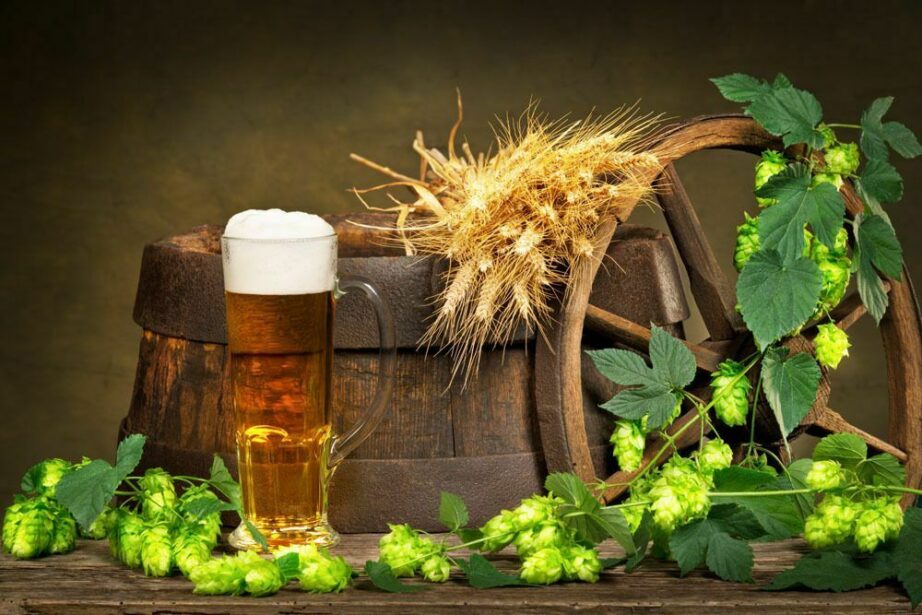Hops That Are Beer Material
And now the fun part! All in all, there are more than 250 different varieties of hops intended for brewing. ‘Cascade’, ‘Citra’, ‘Mosaic’, ‘Simcoe’, ‘Amarillo’ and ‘Saaz’ varieties are among those well known to microbrewery enthusiasts. In North America, it’s relatively easy to get hold of ‘Cascade’ plants, a popular variety widely used in the making of India Pale Ales. You can also get your hands on ‘Centennial’, ‘Chinook’, ‘Willamette’ or ‘Nugget’ plants.

The interest of the different varieties is that each one has its own aroma and bitterness. True brewing enthusiasts refer to very specific charts that show levels of alpha acids, beta acids, essential oils and various terpenes. For example, ‘Nugget’ will give a more bitter beer with aromas of spices and herbs. For a touch of citrus, choose ‘Centennial’ or ‘Sorachi Ace’. If you want to make a Kölsch, ‘Crystal’ is more popular. And finally, for black beers, my favorites, a mixture of ‘Cascade’ and ‘Galena’ produces a small miracle!

Harvest at the Right Time
It’s towards the end of summer and the beginning of autumn that hop cones, officially called strobiles, are ready for harvesting. You can tell the cone is ripe when its tips begin to turn brown and its cones are slightly sticky. Next you have to dry them. From this point, we fall into the realm of expertise of the brewer!

Happy beer-loving gardeners will rejoice to see the plant come back faithfully year after year with an equally regular production. You keep the plant healthy simply by adding compost in spring. Adequate watering in spring and when the flowering begins will also help improve production. Also, it is good to know that the hop flowers develop on secondary stems. So, you can encourage the plant to branch out by pinching off its tip when it reaches 6 to 9 feet (2 to 3 m) in height.

Hops are a perfect plant for erecting a visual screen in a backyard surrounded by many prying neighbors.

It’s also a plant that works wonders in city courtyards, climbing up the spiral iron staircases or the many posts of this and that. Imagine… sipping your own home-brewed beer away from prying eyes! That’s happiness! Or should I say “hoppiness”. YES I HAVE HOP SEEDS FOR SALE
 Any questions or if buying, contact me HERE
Any questions or if buying, contact me HERE


We know all the ingredients that make a good cold beer so great. But it was only fairly recently that gardeners realized they could grow a few of these ingredients in their own backyard. And one of these plants is hops. HOPS ARE ALSO A MEDICINAL PLANT-VIEW VIDEO BELOW
Hops are far from being a novelty for horticulturists. We’ve been growing it as a vine for a very long time. But until recently, our choice was limited to the green variety (Humulus lupulus) or the golden one (Humulus lupulus ‘Aureus’). What’s new is that many varieties specially developed for beer crafting are now available.
Get to Know Your Hops
First, a look at the plant itself. As mentioned above, hops is a climbing plant. It will thrive in USDA hardiness zones 4 to 8. With its large, broad, uniquely shaped leaves, it can grow to about 15 to 20 feet (5 to 6 m) in height and cover about 6 to 10 feet (2 to 3 meters) in width.
On the ornamental side of things, you’ll enjoy growing hops for its beautiful and dense coverage, making it a perfect for privacy screening. You’ll also discover hops loves full sun, but you can also manage to get pretty good coverage in less sunny spots.
Hops is also a fast-growing plant. It’s a herbaceous perennial: the stalks die back to the ground completely each winter and it grows right back at an amazing rate. Undemanding in terms of soil quality, it nevertheless prefers well-drained soils that are relatively rich in organic matter.
Not Quite Perfect
“Great!” you might say, “It seems to be the perfect climbing plant!” Well, before going that far, let’s read the fine print. You see, there is one item we need to talk about: its incredible vigor.
Hops can be very domineering. Imagine! It grows from the ground practically to the sky each spring, wrapping around stakes, trellises, trunks and branches as it clambers upward. And yes, it does develop suckers; little offshoots that can appear at some distance from the original plant from underground or from creeping stolons.
Over time, the plant will expand considerably in width; under some conditions, it can become gigantic! Luckily, it’s easy to control. You can pull out unwanted growth in the garden (wear gloves, some people find the sap irritating) or limit its expansion into the lawn by mowing it down with the lawn mower.
Another particularly important detail you need to know if you want to grow the hops for craft beer production: hops is a dioecious. This means that there are male plants and female plants. To produce fruits needed for beer, you don’t want the female flowers to be pollinated. That alters the taste of the hops.
So, buy named varieties to avoid growing male plants. (If you grow hops from seed, you’ll have to selectively remove the male hops. Hint; female plants produce cones; males produce open panicle.)